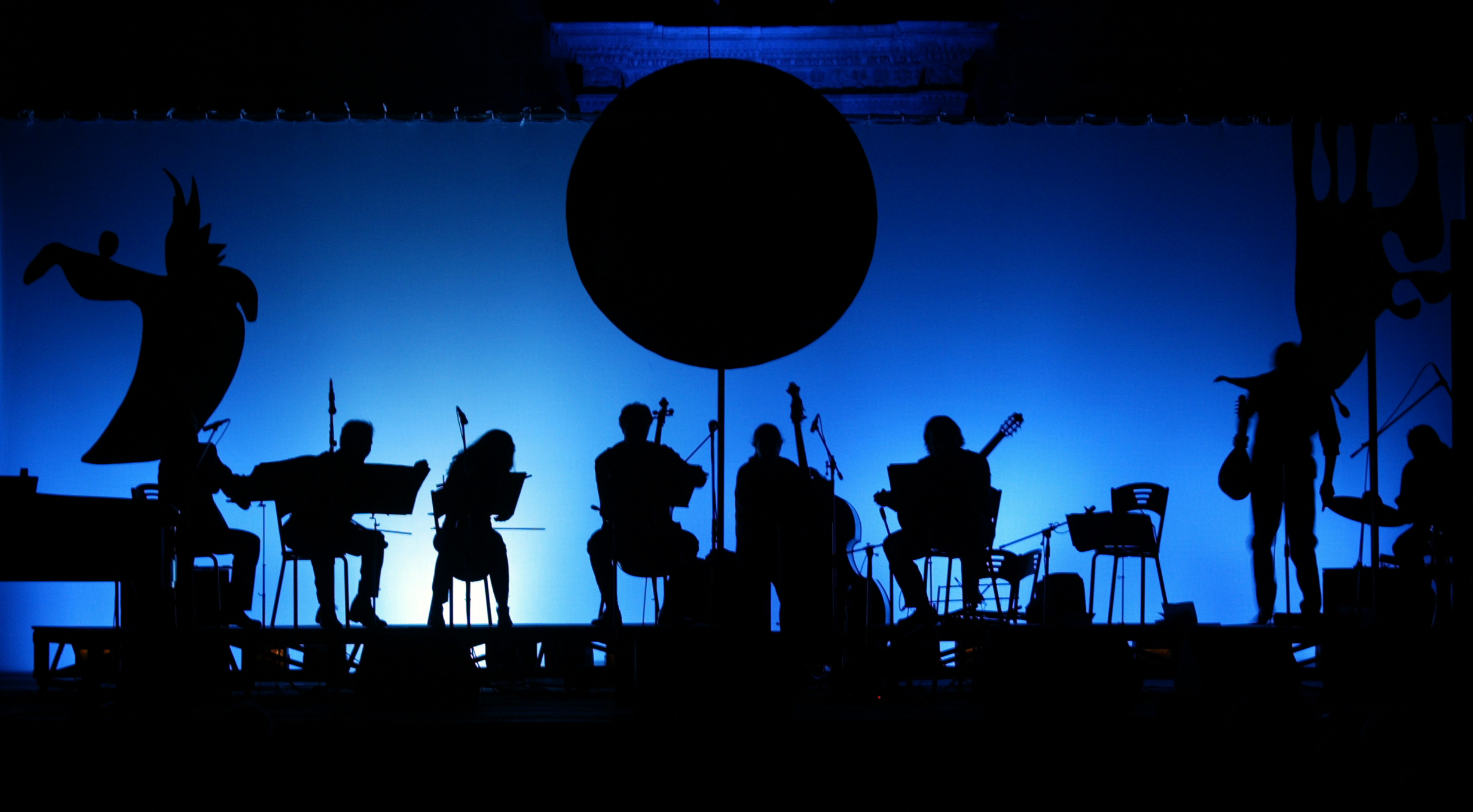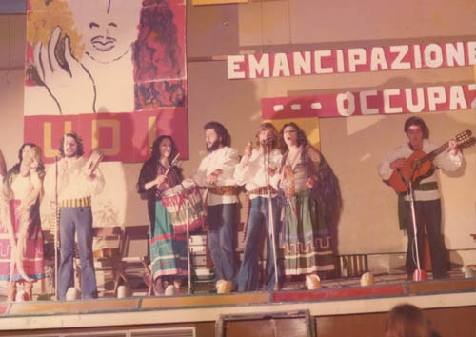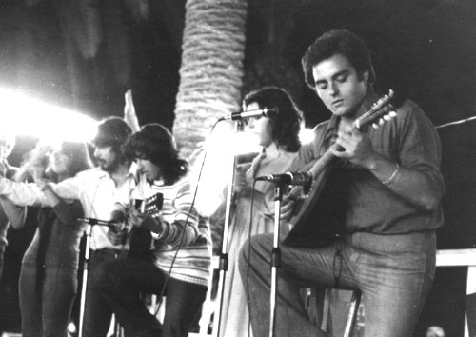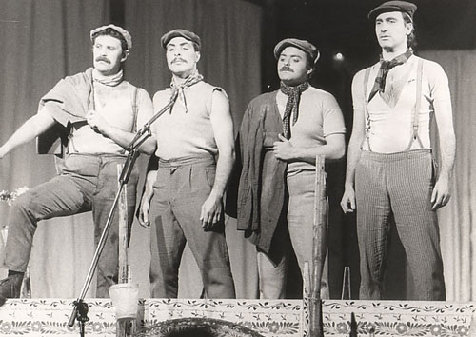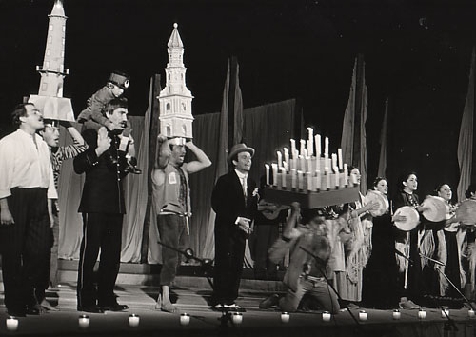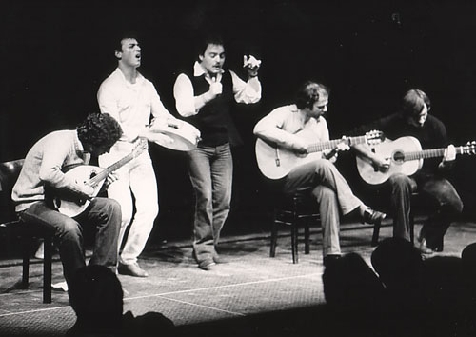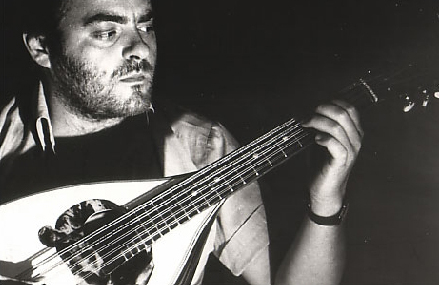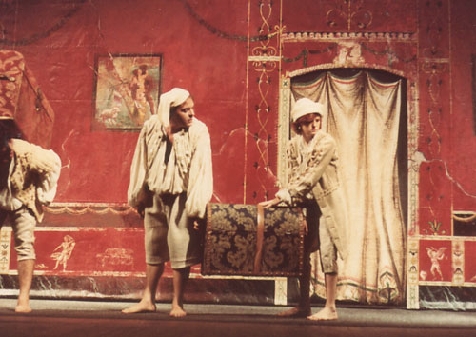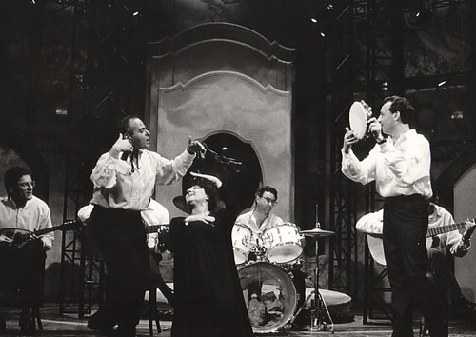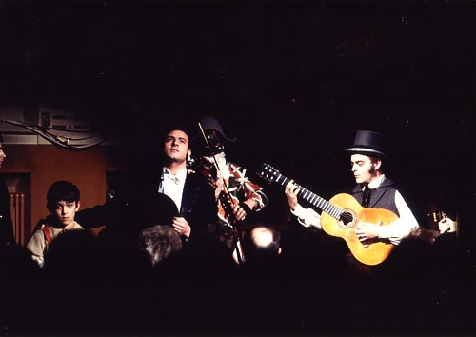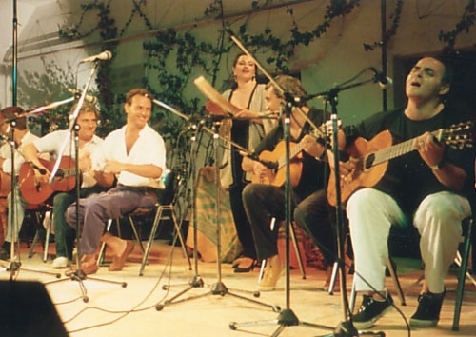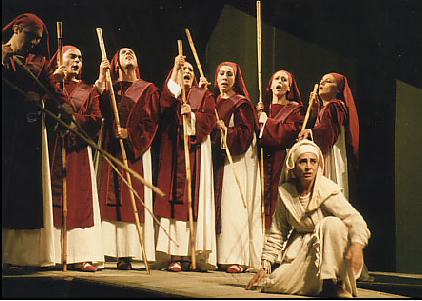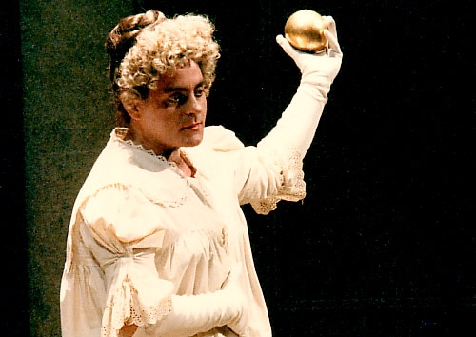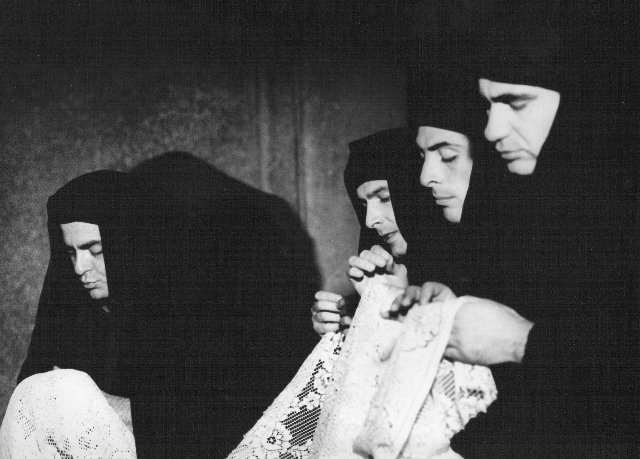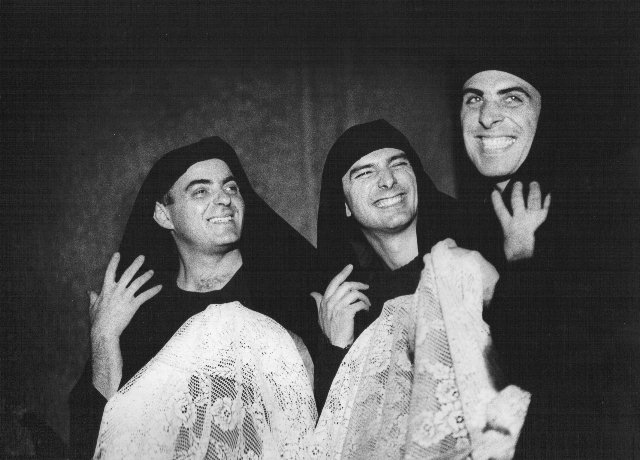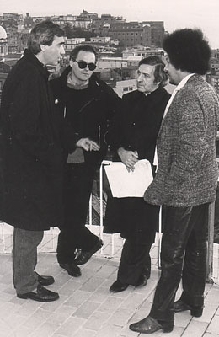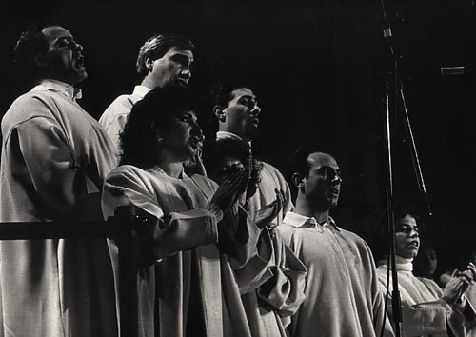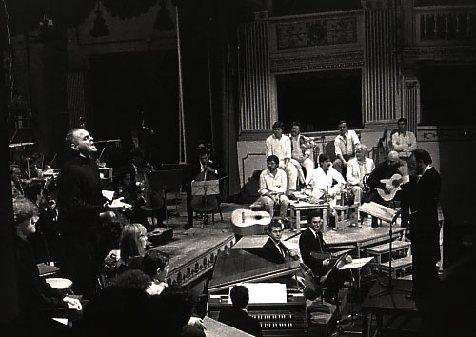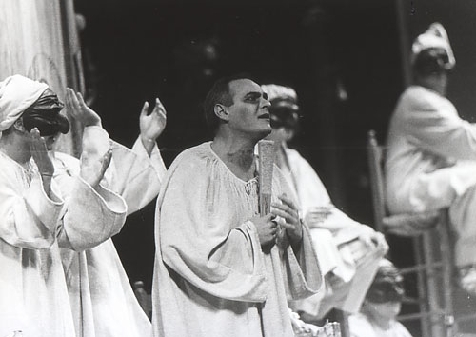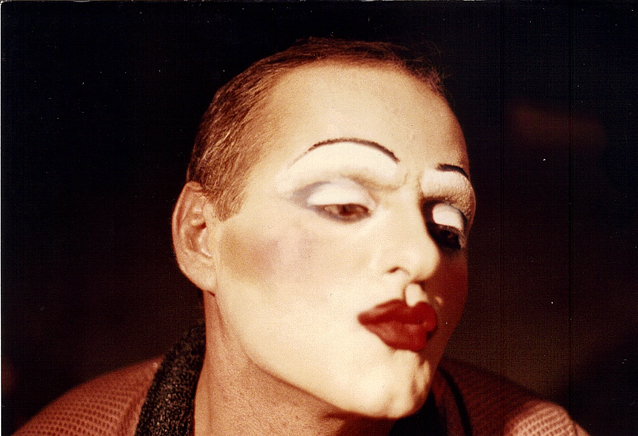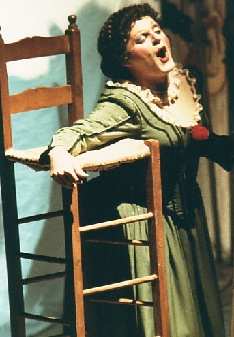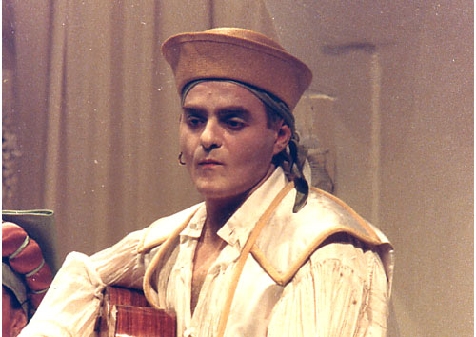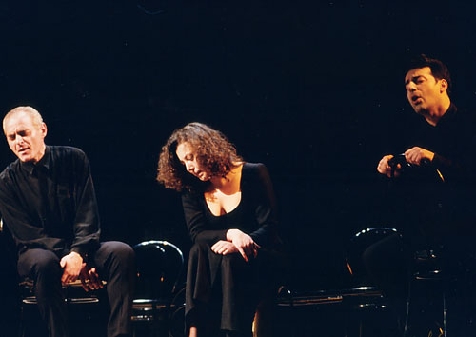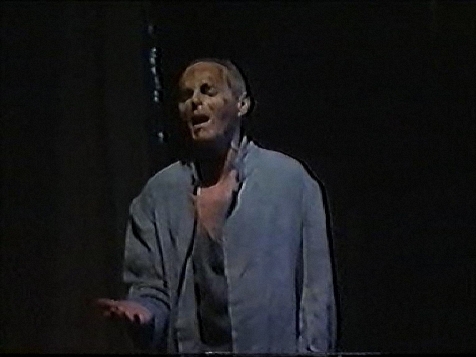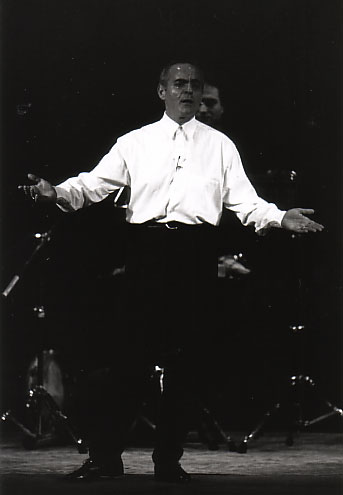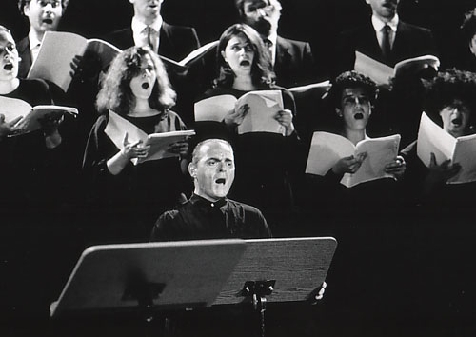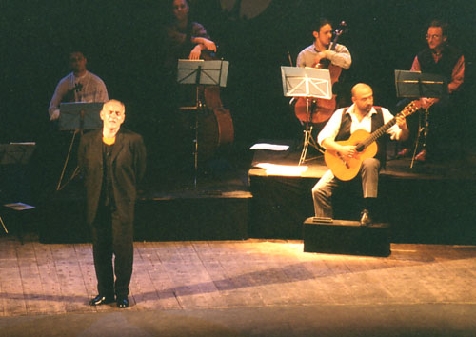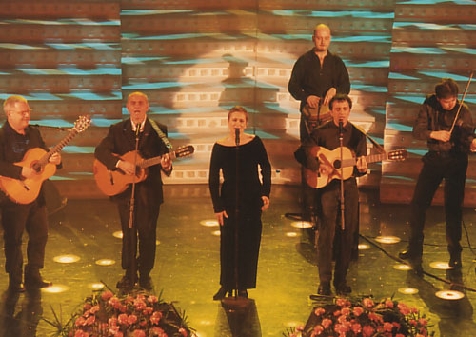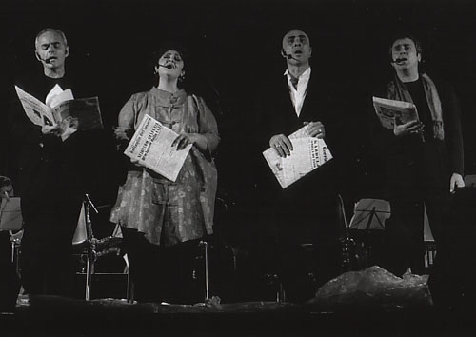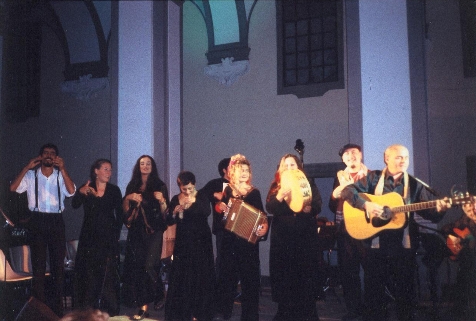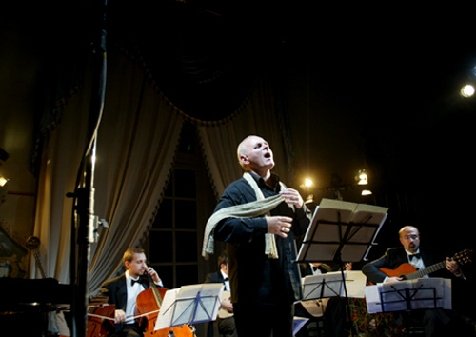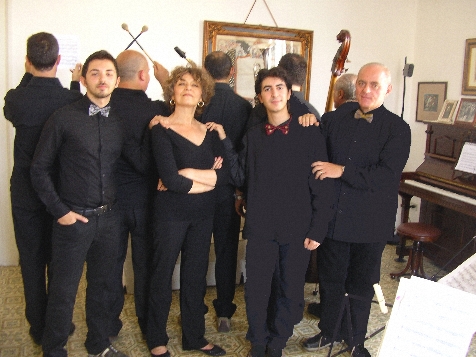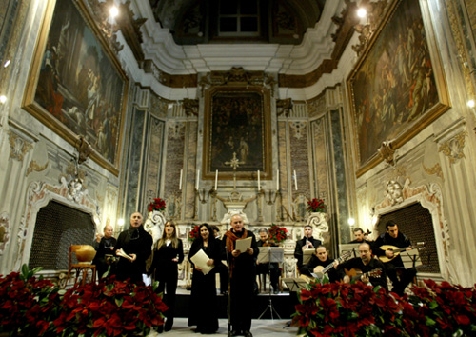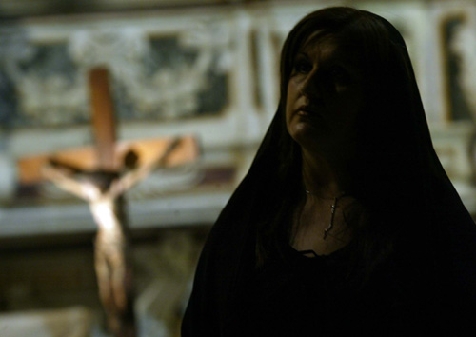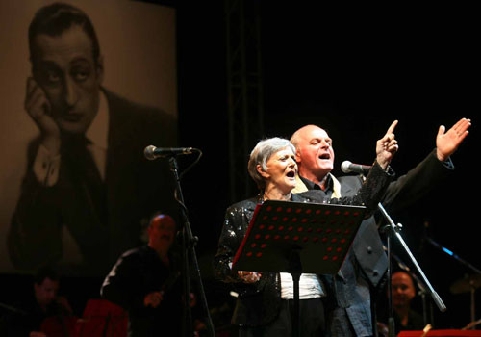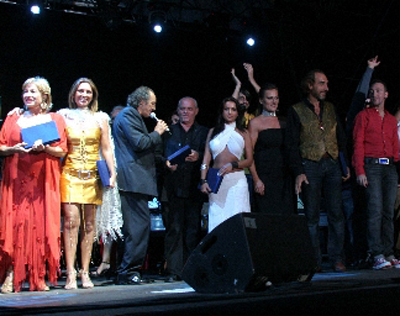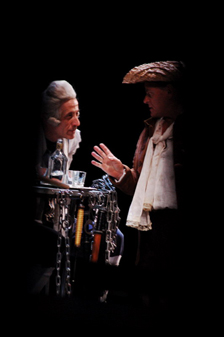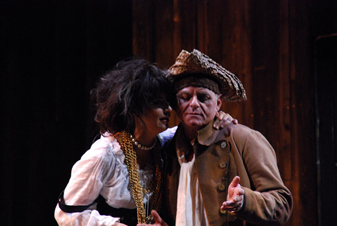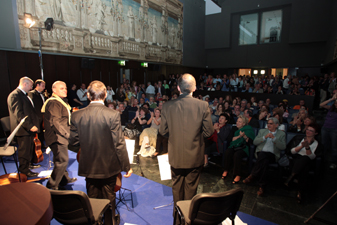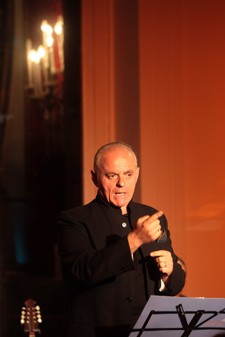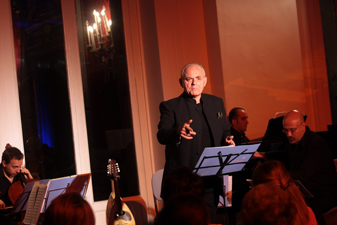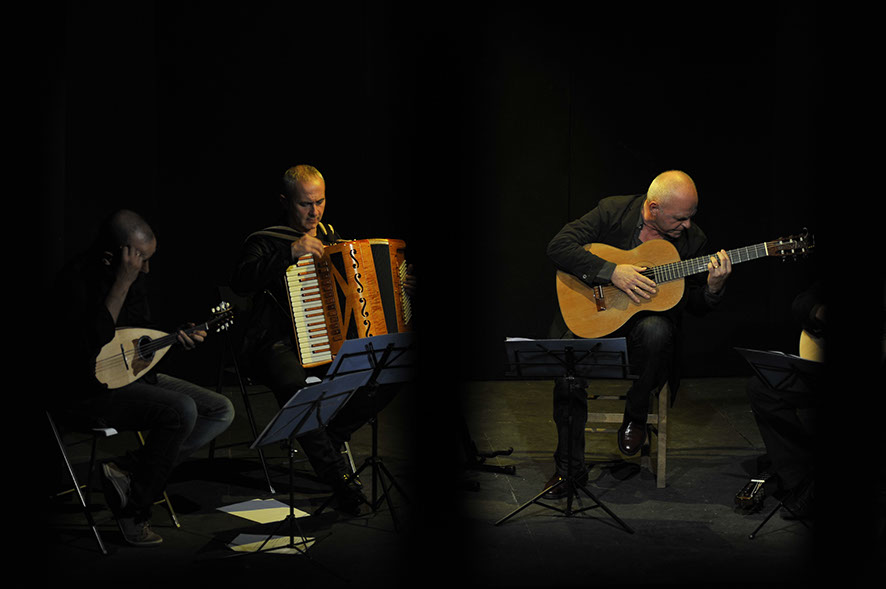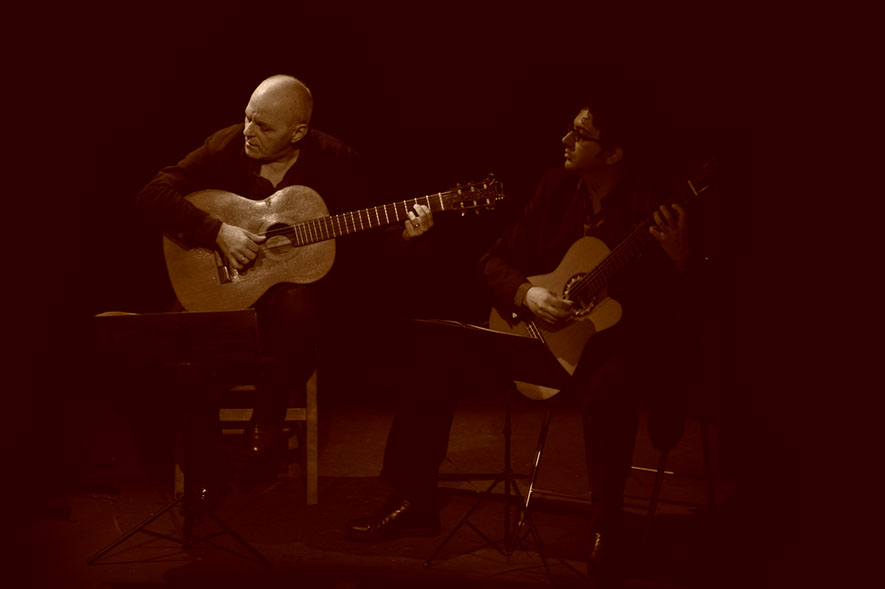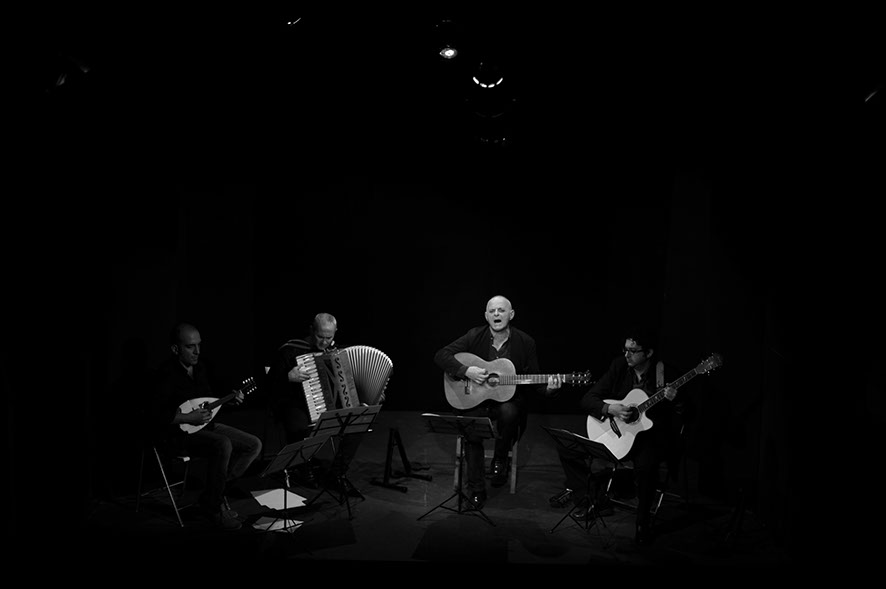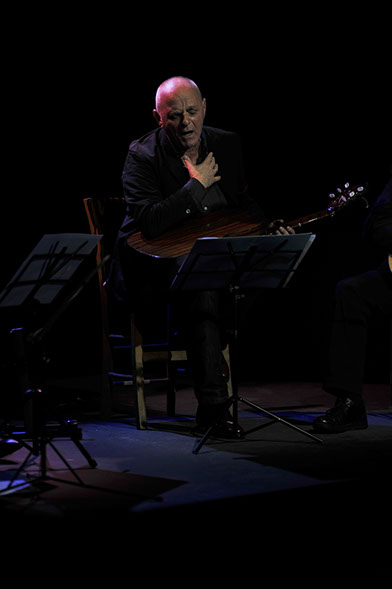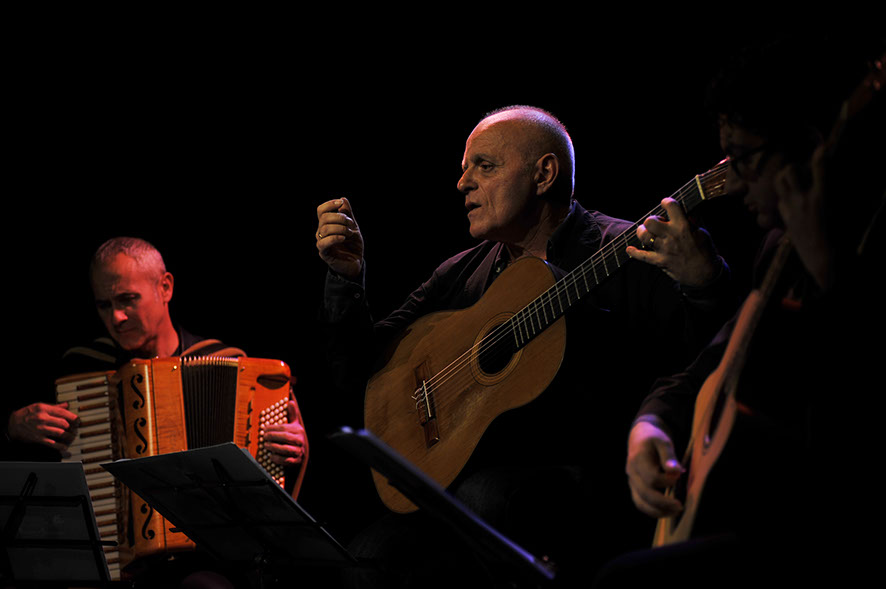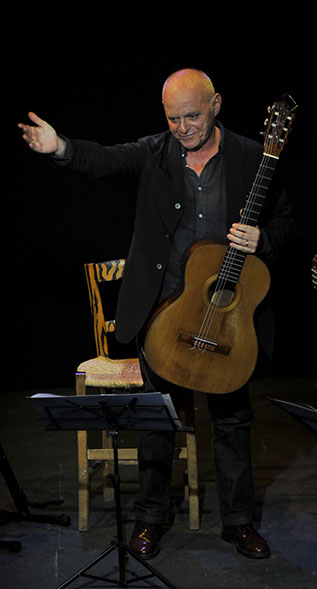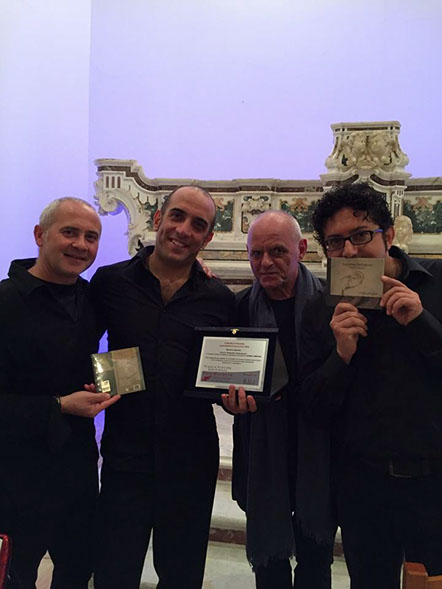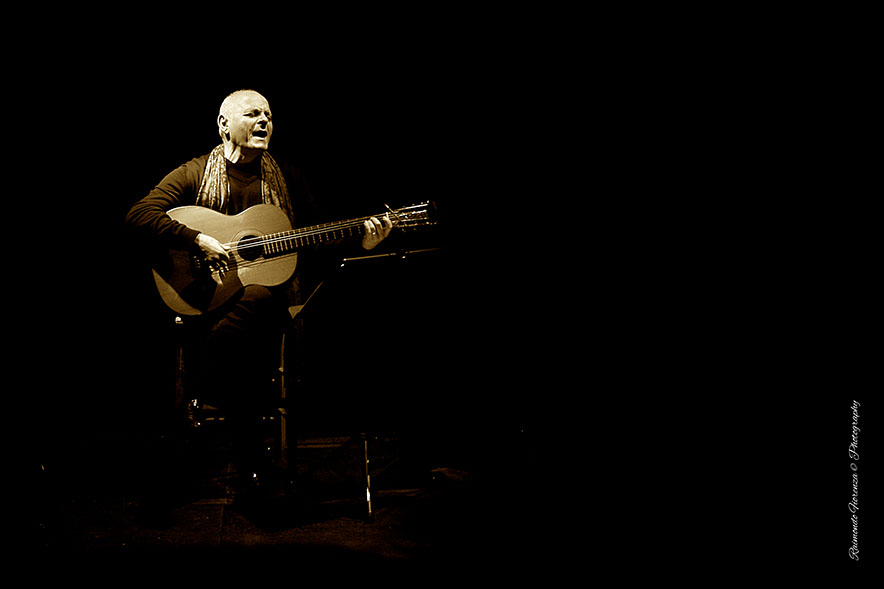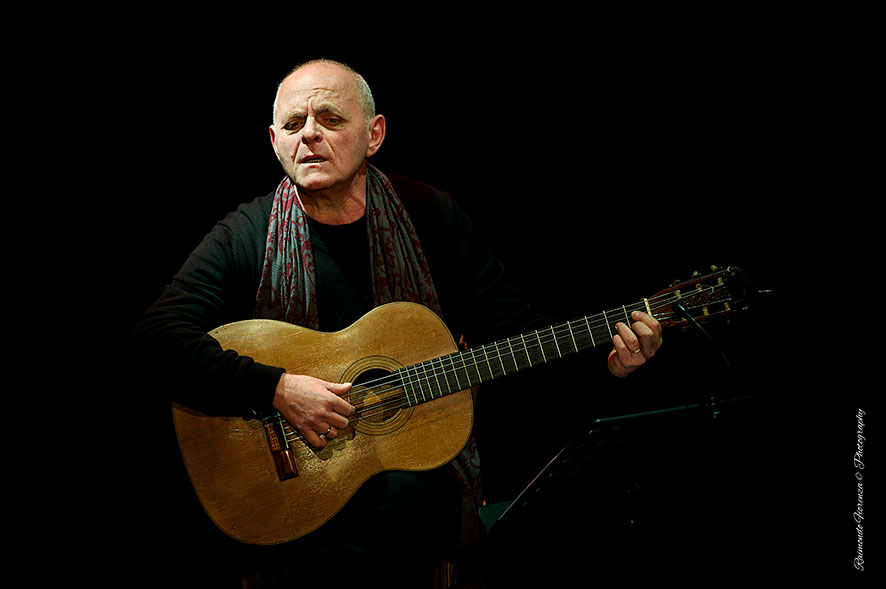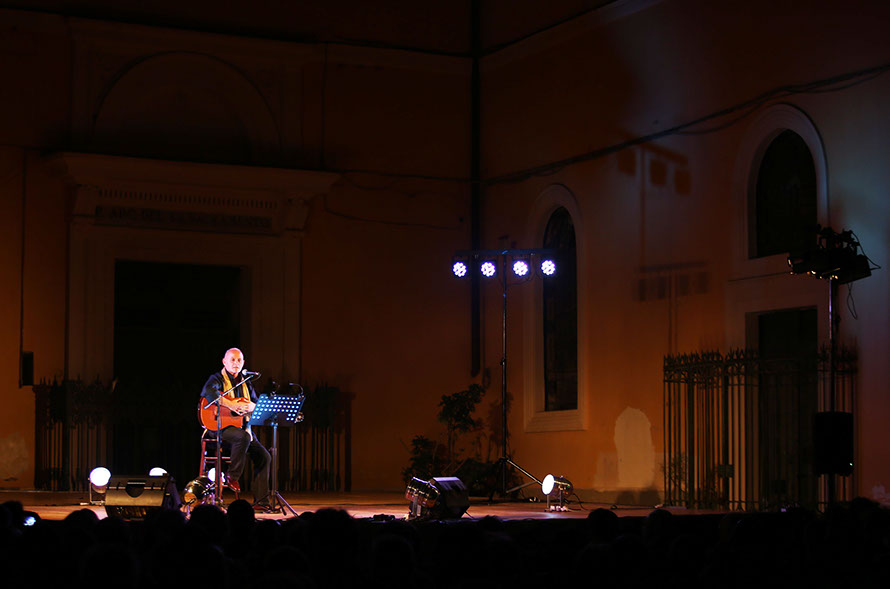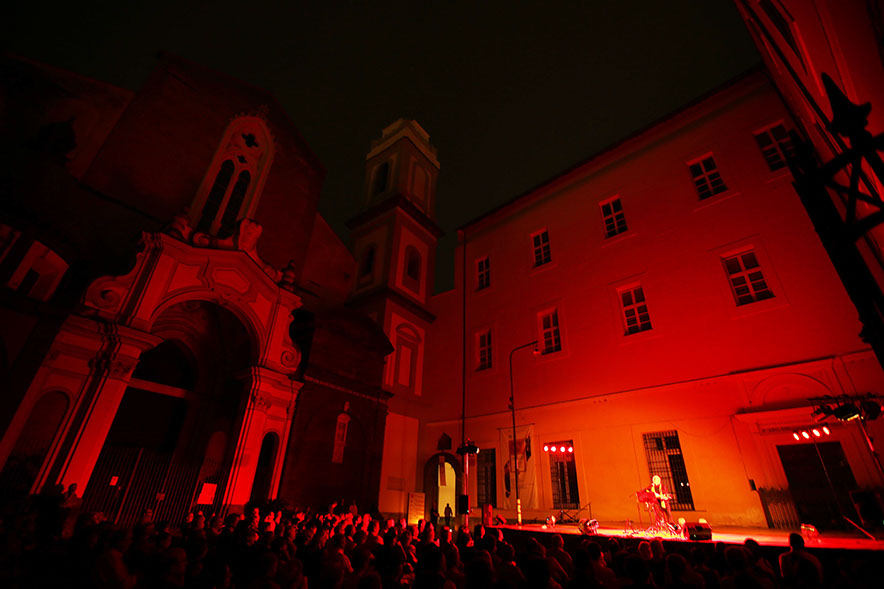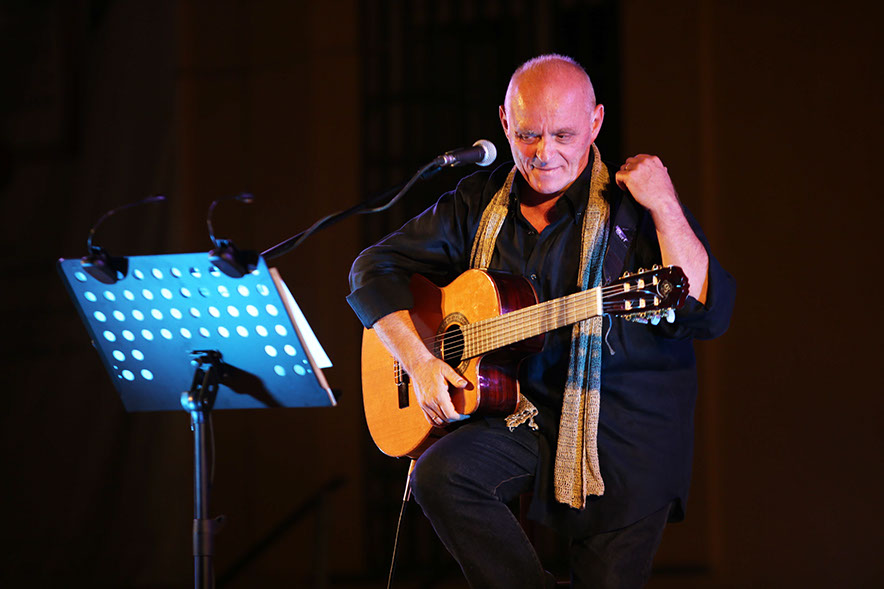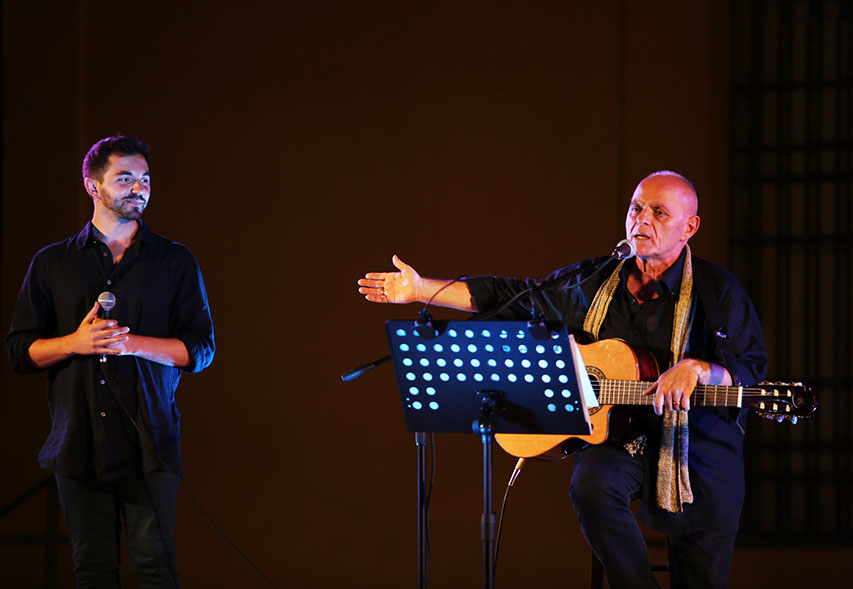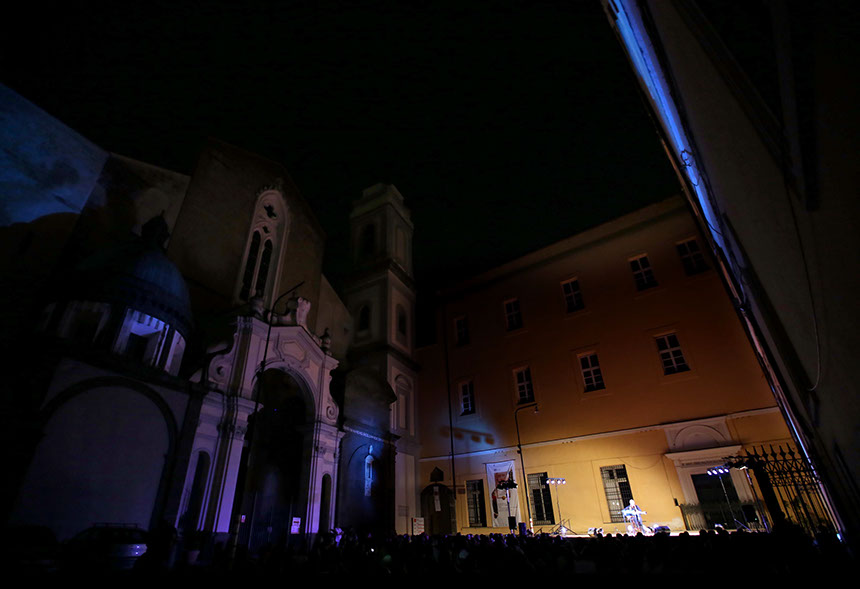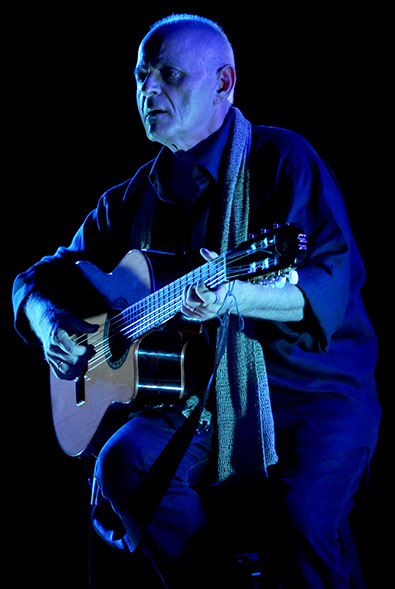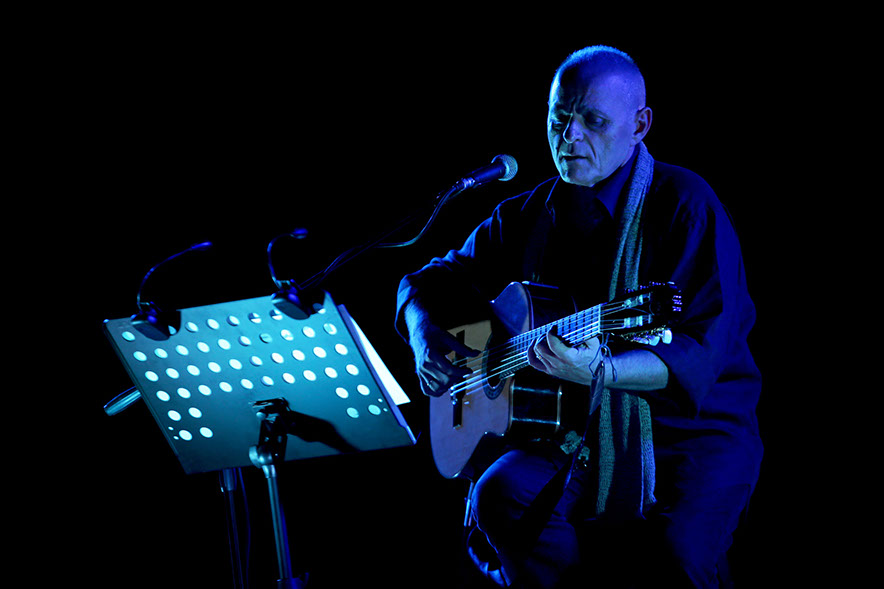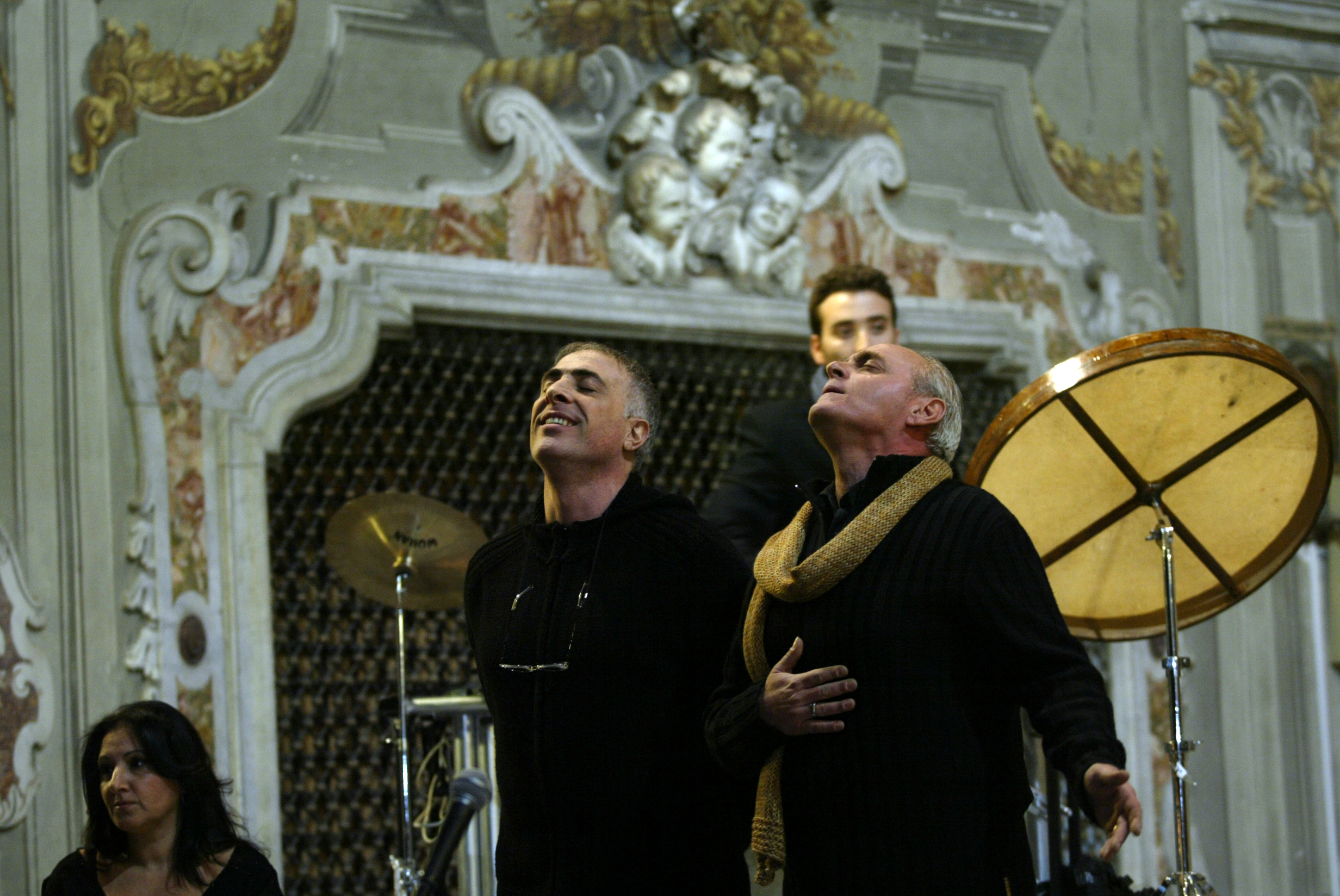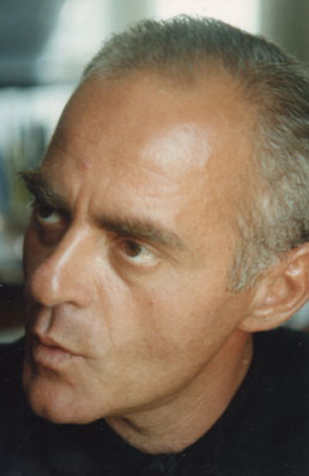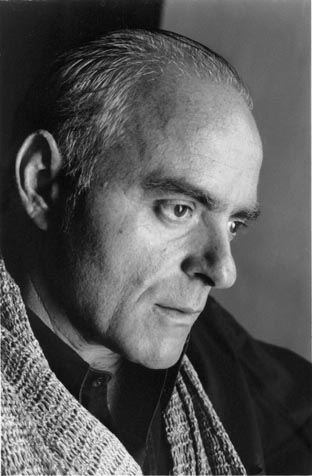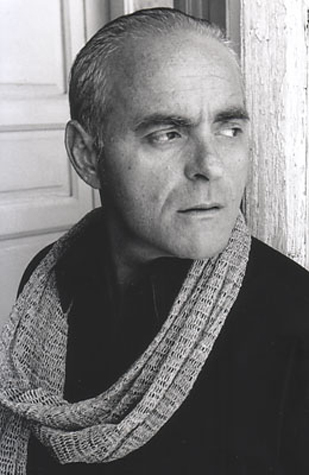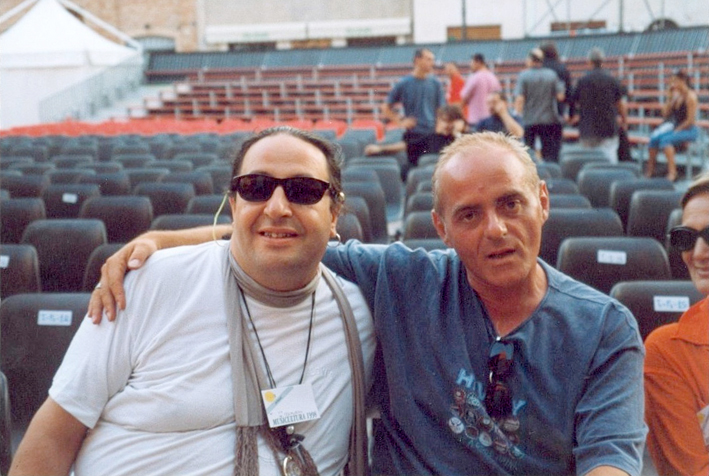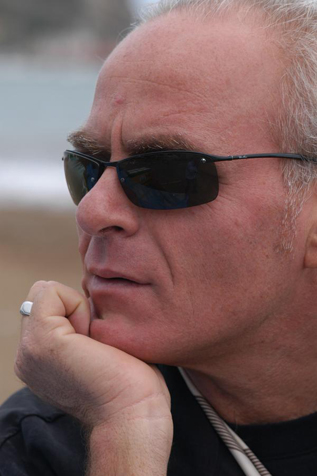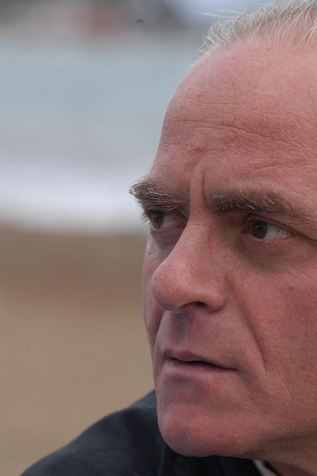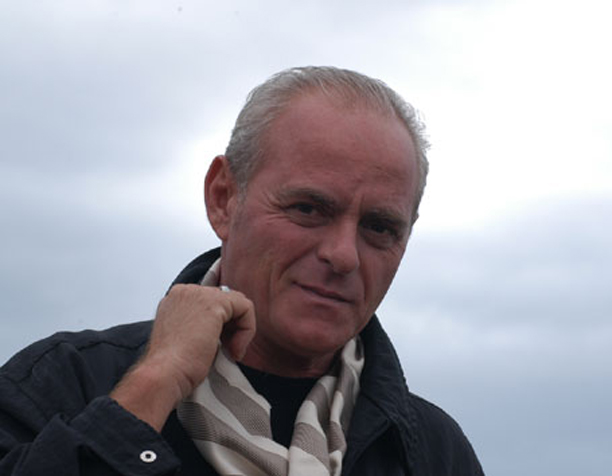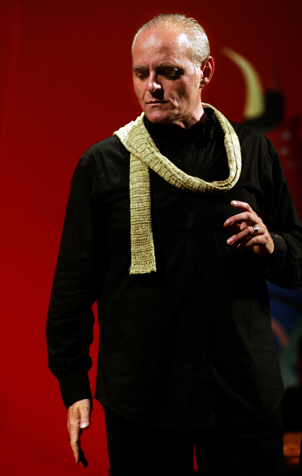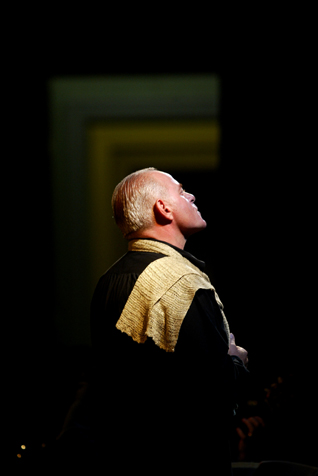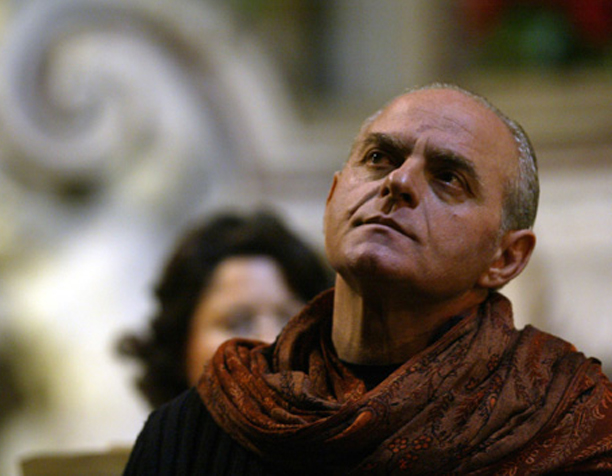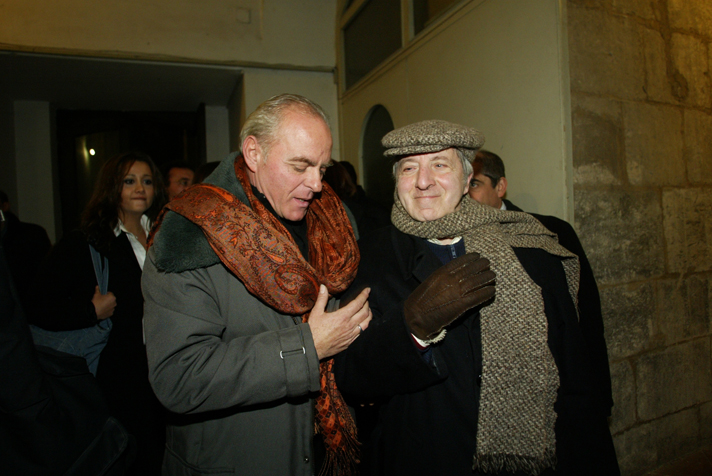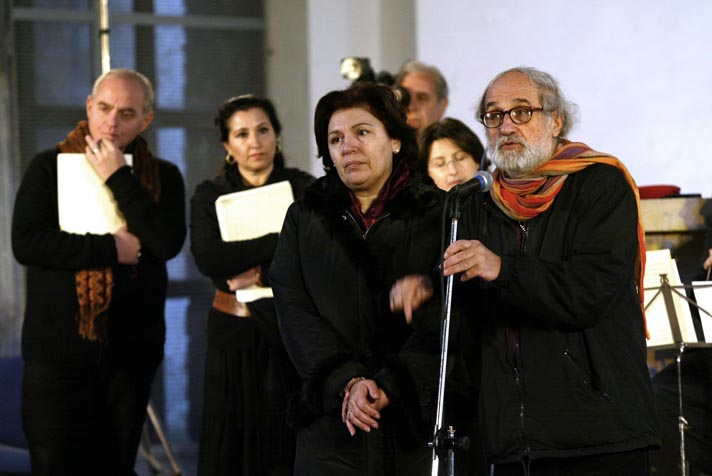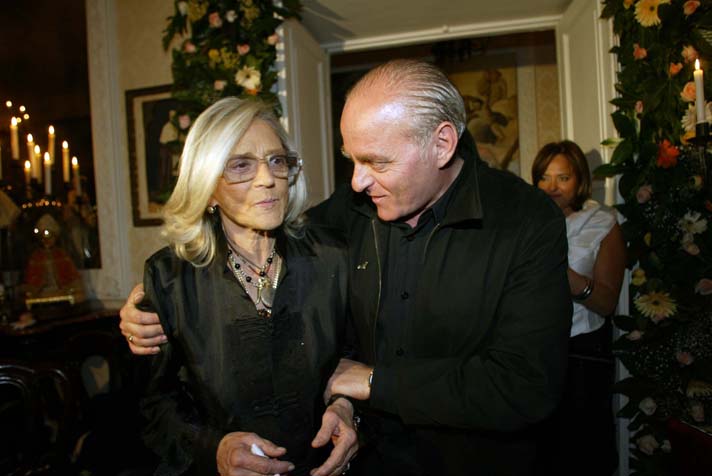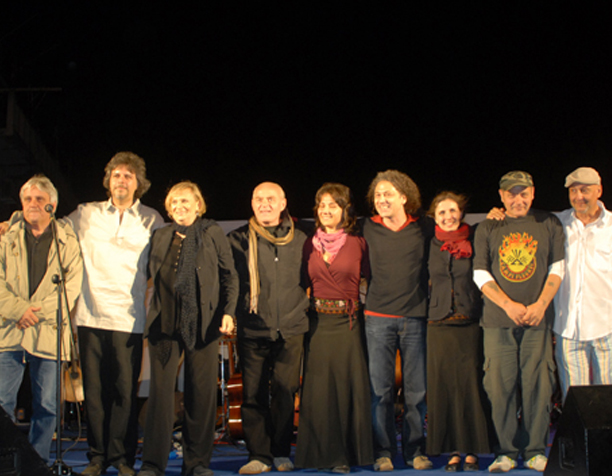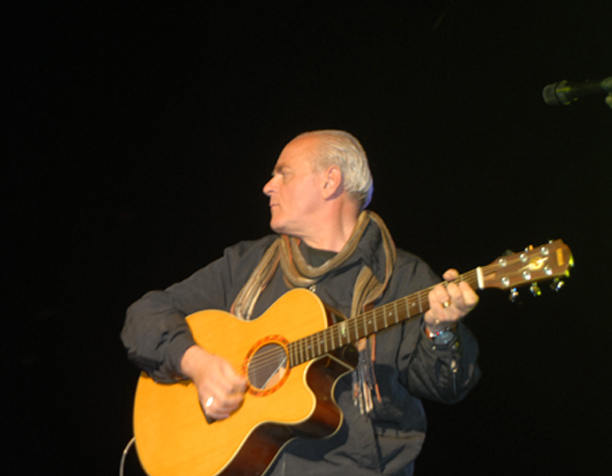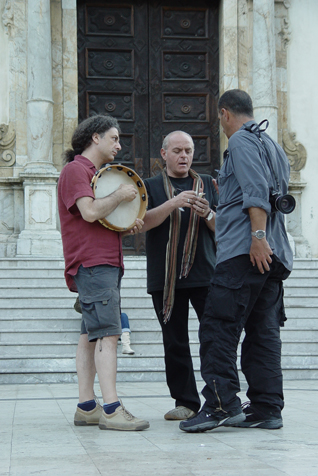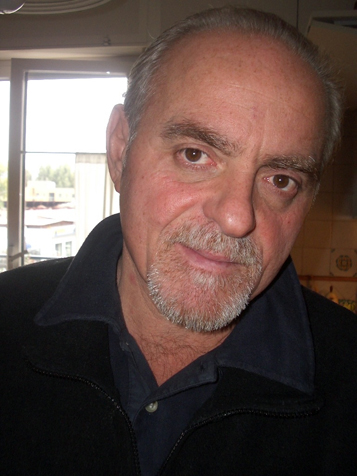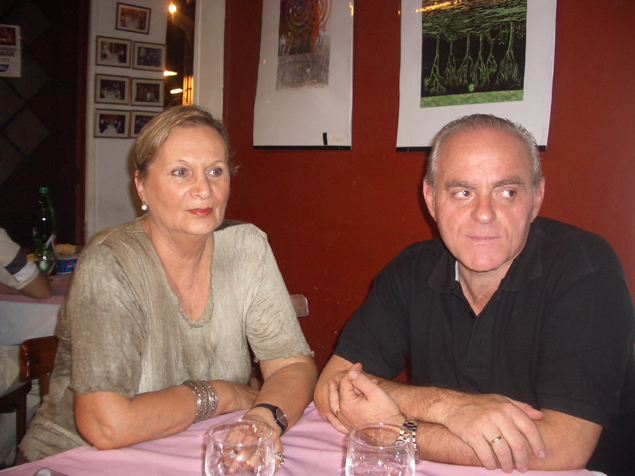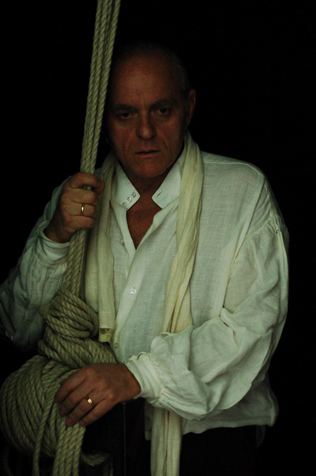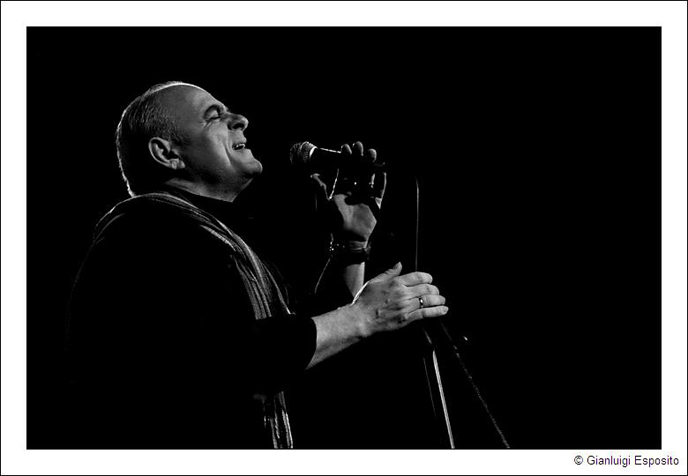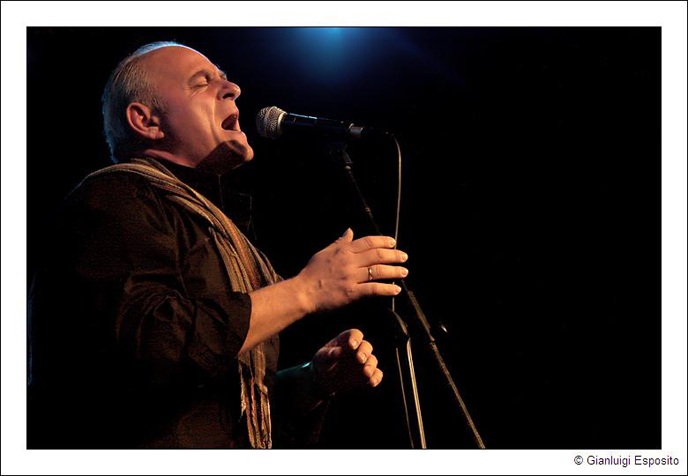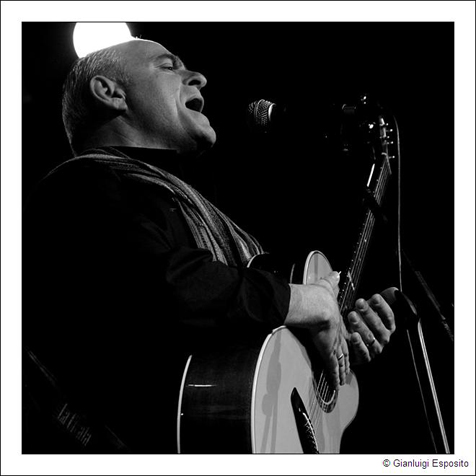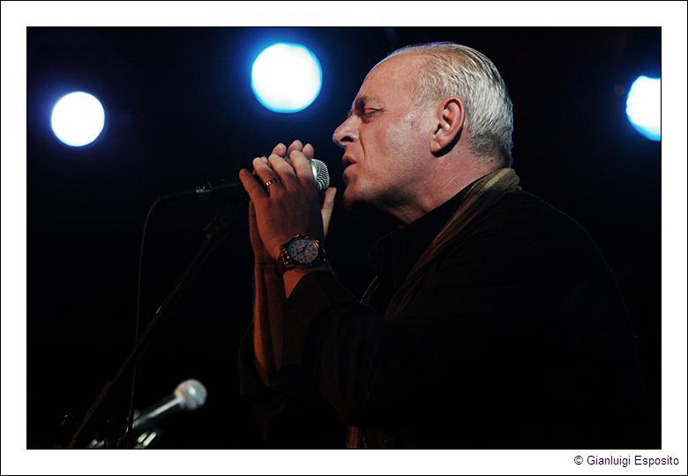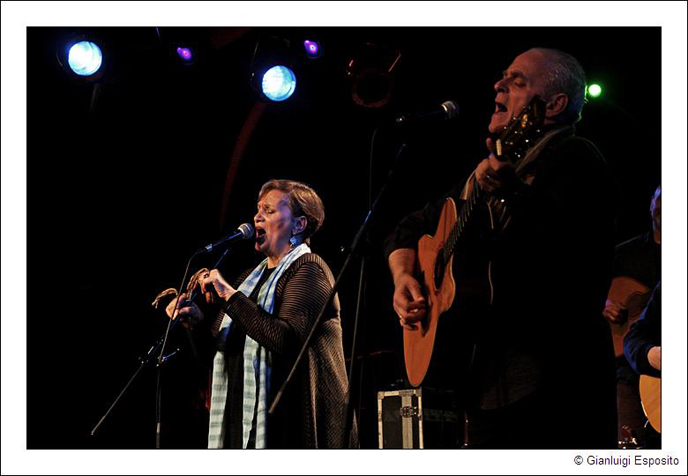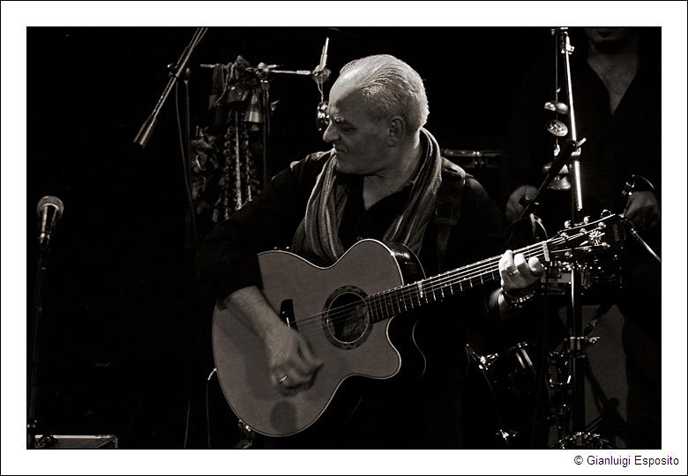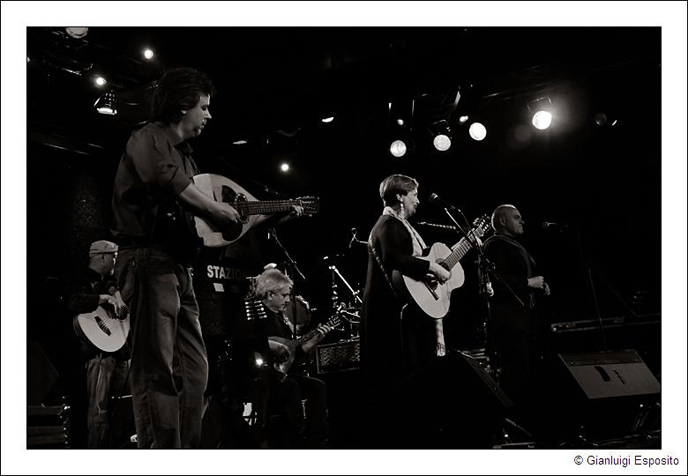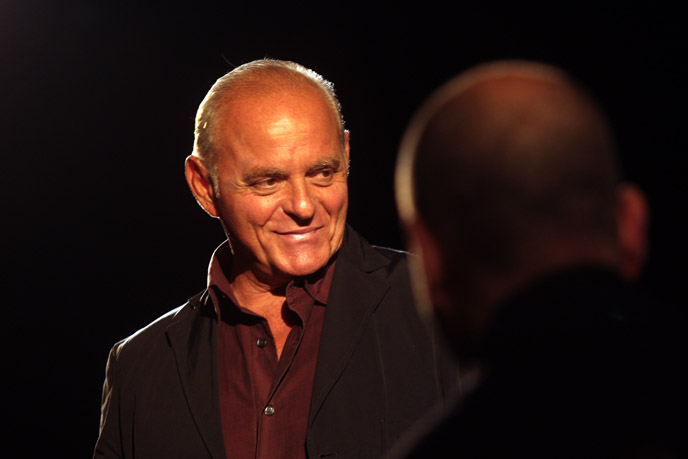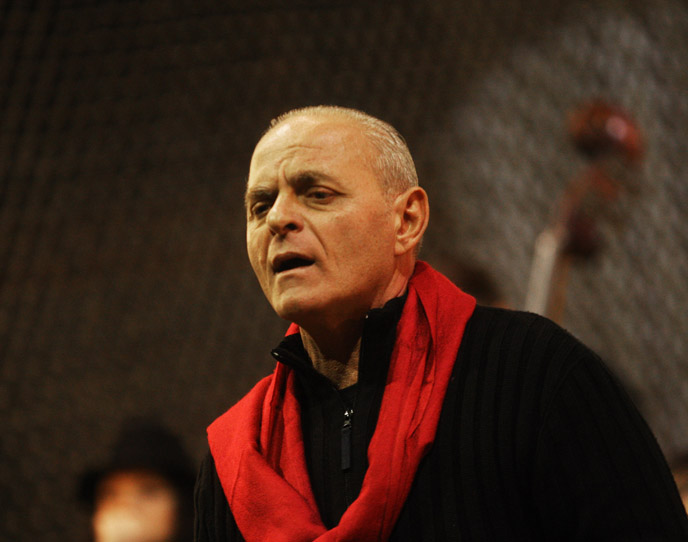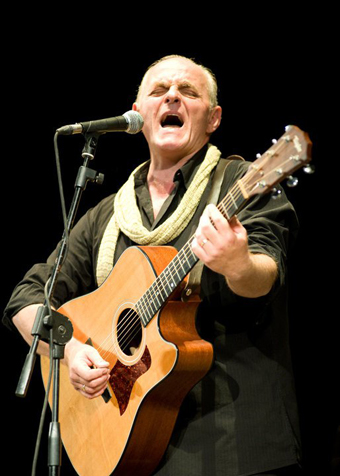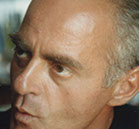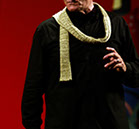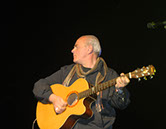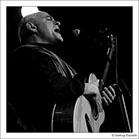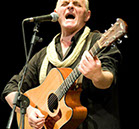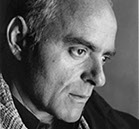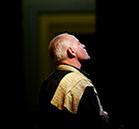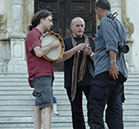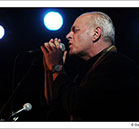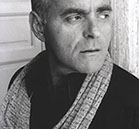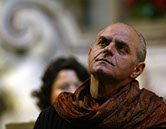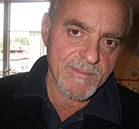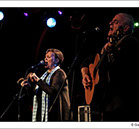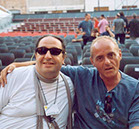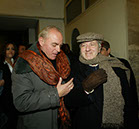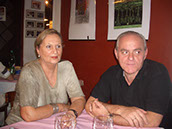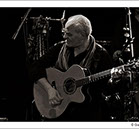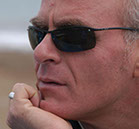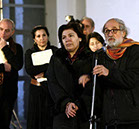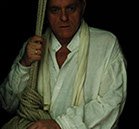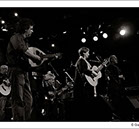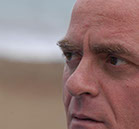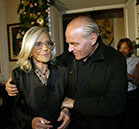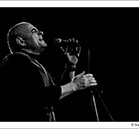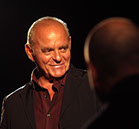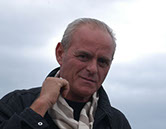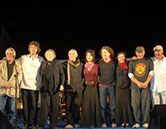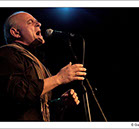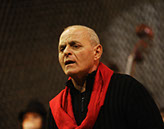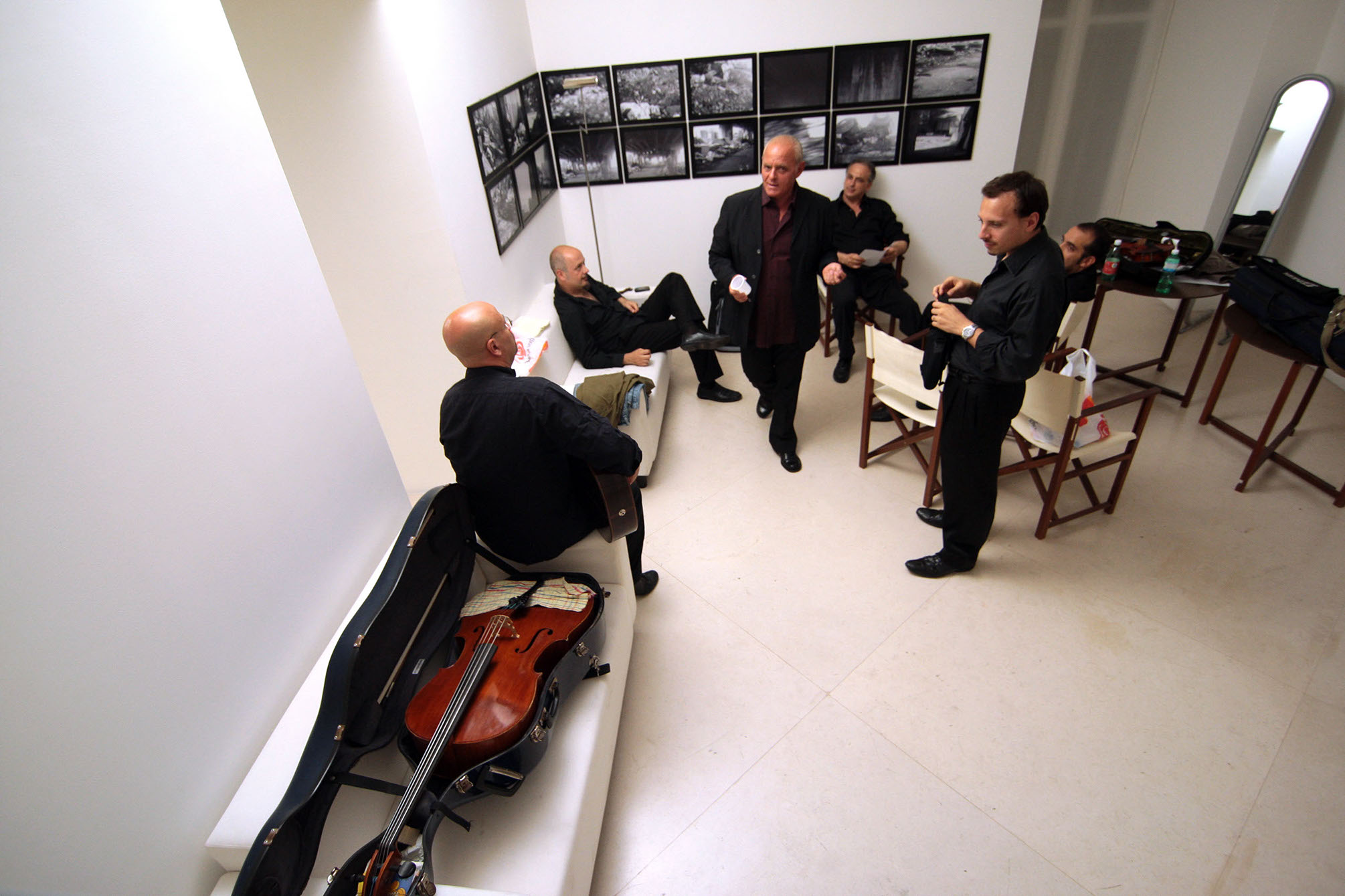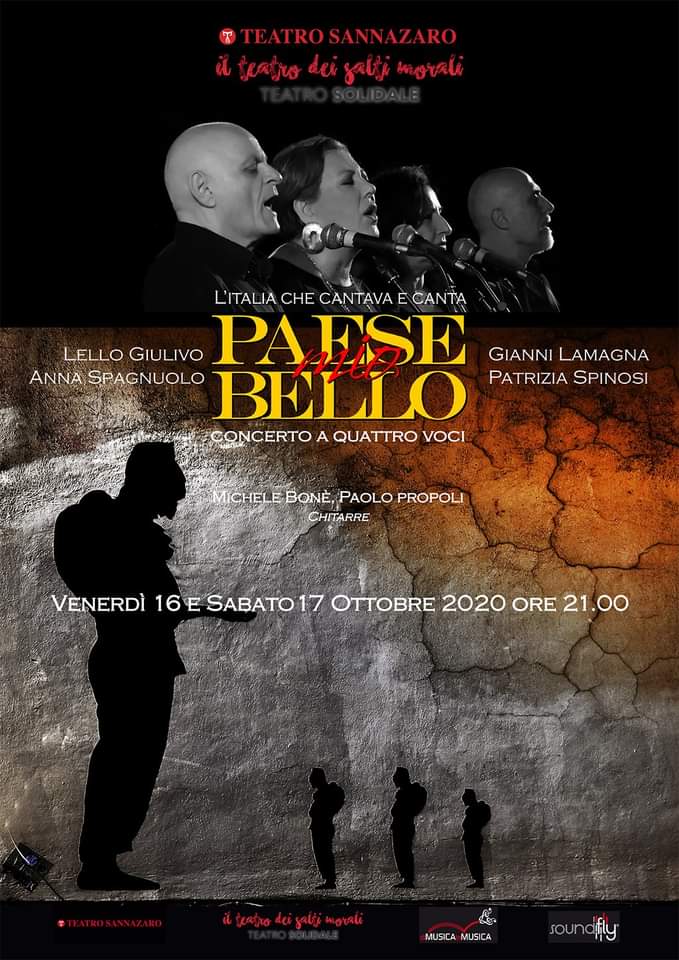
"... To be a poet, it is necessary to have a lot of time, hours and hours of loneliness are the only way to do so that will appear something, which is strength, abandonment, vice, freedom, to give style to chaos.
By now I have little time left: because of death that is coming along, at twilight youth. But also because of our human world, that takes away the bread to the poor, to the poets peace."
P.P. Pasolini
Singer and actor, born in Naples, he makes his debut in 1972.
In 1974, with musician and anthropologist friends he realizes works of research on the music and the theater of tradition, in collaboration with the theatral cooperative I Masaniello until 1976.
In 1979 he joins the company of Roberto De Simone, and begins a study on the vocalism that will afford him to sing the sacred music and the traditional one, the ancient arie and the contemporary music.
Afterward, he partecipates to the most part of the works of the Maestro, from the theatrical musical ones:
La Gatta Cenerentola, L’opera Buffa del Giovedì Santo, Il Canto de li Cunti, Il Drago, Dedicato a Maria, Le 99 disgrazie di Pulcinella, L’Opera dei Centosedici etc. to the operatic ones: Piedigrotta, Crispino e la Comare, Requiem per Pasolini, Stabat Mater, Carmina Vivianea, Cantata per Masaniello, Le Cantatrici Villane.
In 1980 he is among the foundators of the band Media Aetas, and participates to numerous international festivals in Italy and abroad (Germany, France, Spain, Israel, Russia, Iraq, USA, Brasil, Algeria, Mexico, Argentina).
Since 1991 he collaborates with Antonello Paliotti, musician and compositor with whom he realizes the Recitals: S’io fosse, DediCanto, Amate Cantate, Coppola Rossa and Le Forme Incantate, presented, with big success, in Italy and abroad.
In 1996 he founds the association di Musica in Musica for promoting new initiatives in the field of the diffusion of the music and for the discover of new talents among the new generations.
In the following years, he participates to the festival of contemporary music: Performance intorno a Warhol, he is the voice in the album Condannati a vagare sui mari by the Colin Muset Ensemble, soloist and narrative voice in the concert Lauda Intorno allo Stabat, soloist in the concert Vox Animae with Mariano Rigillo and the Soloists of the San Carlo Theater of Naples.
In 1997 begins his official collaboration with the Nuova Compagnia di Canto Popolare (Sanremo ’98, Malelingue Tour N.C.C.P. & 99 Posse, Li Saracini adorano lu Sole) and since that date he collaborates effectively to the intense live activity of the band in Italy and throughout the world.
In 1999 in collaboration with the association Misenvm he creates the festival of music Aperture, musica nei luoghi negati annual musical appointment of which he is the artistic director.
In 2000/01/02 he is again by Mariano Rigillo's side in the Concert Show Simme Zingare by Raffaele Viviani. Protagonist in the concert Il Musicista Segreto for the bicentury of the death of Domenico Cimarosa.
In 2003 he is among the protagonists of the event I Maledetti del 900 with, among others, S. Rubini, A. Haber, Tito Schipa jr, Monica Scattini, and he is the author of the project on the music of the italian emigration: Maremigrante.
In april 2004, he presents the new recital Le Forme Incantate for the inauguration of the manifestations of the Maggio dei Monumenti and in december, the same year, the concert Racconti e Musiche per i Giorni di Natale.
In May 2005 he publishes the CD I Cottrau a Napoli that afterward becomes a live event, presented in september 2005 at the Museum of Capodimonte.
In april 2006 he is the author of the project Madri dolorose, veglia in musica e parole per le ore della passione, for soloist, orchestra and narrative voice. In may 2006 he is protagonist of the concert Nei Mari della Luna, sogni di musica nell'800 e... oltre.
In summer of the same year he brings his Forme Incantate in prestigious places in Italy and abroad and collaborates to the realisation of a show tribute to the Quartetto Cetra entitle A la manière de... il Quartetto Cetra. In december 2006 he reproposes with a big success the by now consolidated event Racconti e Musiche per i Giorni di Natale that has reached its 4th edition.
The beginning of 2007 is very fortunate with a beautiful concert of I Cottrau a Napoli in the beautiful 18th century theater of the Ambassy of Italy in France on commission of Eutelsat.
In april 2007 in other symbolic places, the Basilica of S. Maria alla Sanità and the Cloister of S. Maria La Nova, two concerts of the Holy Week's one Madri Dolorose.
In may the big event in occasion of the 40th anniversary of the death of Totò Concerto per un Principe.
2008 begins with the partecipation to the production by the Public Theater Bologna of the Beggar's Opera directed by Lucio Dalla that have been represented even in the theatres of Modena and Reggio Emilia. In may he presents with succes his concert M'aggio Incantato, in the Museum of Capodimonte. In october he gives his Concerto Per Capri concluding the exhibition Krupp e la Cultura Tedesca in Capri.
2009 begins with the publication of the new album Ninna Nanna Senza Nome, in february and in march he is among the protagonists of the Opera Buffa La Locandiera by Pietro Auletta (1738) a co-production between the Conservatory Domenico Cimarosa of Avellino and the Theater Carlo Gesualdo with a direction by Bruno Garofalo and producted by Carmelo Columbro. In May 2009 the event Gemito di Mare e di Amori a concert dedicated to the Neapolitan sculptor Vincenzo Gemito during the exposition presented by the Ministry of Cultural Heritage and Activities (Italy) and the Neapolitan Museum Pole in the Pignatelli Museum of Naples.
In May 2010, for Raitrade, is released the album Concerto per un Principe chiamato Totò.
in December 2011, produed by diMusicainMusica, Racconti e Musiche per i Giorni di Natale, is the new album.
In 2012 he released the album "Amate Cantate Napoletane" for the historical Neapolitan record Phonotype Records, meanwhile was born the idea of translating into Neapolitan, and to set them to music, some Shakespearian sonnets.
In 2013 and 2014 are performed concerts "Sulo", a return to the early career, a program of Neapolitan songs rarely performed for only voice and guitar, and "Ll'urdemo 'nnammurato" forgotten songs of Naples, performed in a quartet, and the show of theater / dance "La Cattedrale nel Vento" written and directed by the German choreographer and dancer Yvonne Pouget and staged in Monaco of Bavaria in November 2014.
It's during these years that the work around Shakespeare takes shape,and that seventeen of 154 sonnets of the Bard are chosen, translated into the language of Naples and set to music. Started the making of the album, and between arrangements, recording, mixing, mastering and all that entails such work comes the end of 2014.
Neapolitan Shakespeare is ready, and in June of 2015 is published and distributed by Europhone Records.
As of 2016, he is still the solo male voice of the NCCP 50th anniversary record "50 anni in buona Compagnia".
In 2018, the idea for the concert "Paese Mio Bello, l'Italia che cantava e canta" was born, a concert for four voices with Lello Giulivo, Anna Spagnuolo and Patrizia Spinosi, lifelong friends with whom he shared theater and music since the late 70s. Paese Mio Bello debuted in December 2018, has toured both in Italy and abroad with great success and the first album will be released soon.
The year 2020 opened with the presentation concert in Rome of the last CD of the NCCP "Napoli 1534, tra moresche e villanelle ...".

GIANNI LAMAGNA
Biography
2015
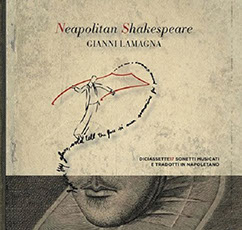
NEAPOLITAN SHAKESPEARE
17sonnets translated in Neapolitan and set to music
1. 'o cinquantacinche / Sonnet 55
2. 'o sittantasei / Sonnet 76
3. 'o cientovintotto / Sonnet 128
4. 'o vintitre / Sonnet 23
5. 'o diciotto / Sonnet 18
6. 'o cientotrentasei / Sonnet 136
7. 'o dicessette / Sonnet 17
8. 'o nuvanta / Sonnet 90
9. 'o vintinove / Sonnet 29
10. 'o nuvantuno / Sonnet 91
11. 'o cientoquarantuno / Sonnet 141
12. 'o cientessidice / Sonnet 116
13. 'o tre / Sonnet 3
14. 'o sissantaquatto / Sonnet 64
15. 'o vintisette / Sonnet 27
16. 'o cienteùnnice / Sonnet 111
17. 'o sissantasei / Sonnet 66
2012
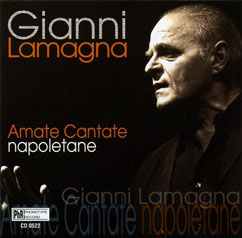
AMATE CANTATE NAPOLETANE
Reprint of the album of 1997 with new songs
1. 'A Vucchella
2. Silenzio cantatore
3. La Luisella
4. Lo Marenaro
5. S'io fiosse
6. Ammore 'nnucente
7. L'acquaiuolo
8. Core 'ngrato / Chi tene 'o mare / Alleria
9. Napulitanata
10. Serenata napulitana
11. Nanassa
12. Indifferenza
13. E bonasera ammore
14. Palomma 'e notte
15. 'O surdato 'nnammurato
16. Lla rì lli rà
17. Tammurriata cafona
18. D' 'o mare e dd' 'e rrose
2011
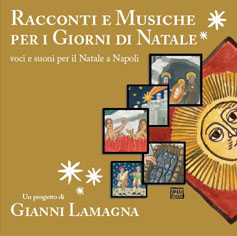
RACCONTI E MUSICHE
per i giorni di Natale
Voices and Sounds for Christmas in Naples
1. Saccio na bella canzone
2. 'O Zampugnaro 'nnammurato
3. Natale e simm'eguale
4. Nonna Nonna
5. Ndindimlbò
6. Natale Napoletano
7. Villanella a Ballo
8. 'A Nuvena
9. Tarantella 'e Natale
10. Strummulillo
11. Rosa d'argento Rosa d'amore/La Santa allegrezza
12. Lu Zampugnariello
13. La Leggenda del Lupino
14. Oj suonno
2010
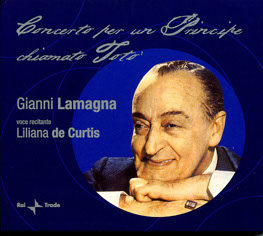
CONCERTO PER UN PRINCIPE
CHIAMATO TOTO'
1. Malafemmena
2. Amore Guaglione
3. Felicità
4. Margellina blu
5. Balcune e Logge
6. Balcune e Logge (adattamento Gianni Lamagna)
7. Core analfabeta
8. Uocchie ch'arraggiunate
9. Tema del "Circo"
10. Paese mio
11. Lusingame
12. Tema della "Banda degli Onesti"
13. Carmé
14. Con te
15. Il bel Ciccillo
16. Ludovico e Sarchiapone
17. Si overo muore 'o Cuorpo
2008
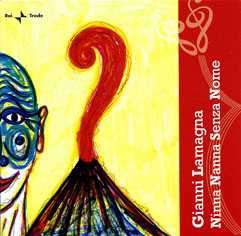
NINNA NANNA SENZA NOME
1. D'acqua
2.Anticipo d'Estate
3. Dint''o Viento
4. Diva
5. Hiroshima
6. Prima o poi
7. J'ai grandi
8.Lato mare
9. Core analfabeta
10. Orecchie rosse
11. Ninna Nanna senza Nome
2006
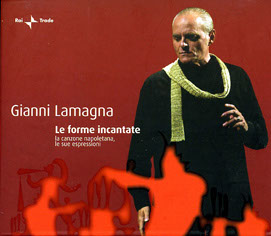
LE FORME INCANTATE
lthe Neapoitan song, its expressions
1. Menta Cedra
2. Maria Marì
3.Lusingame
4. Voce 'e Notte
5. Vieneme 'nzuonno
6. Canzona appassiunata
7. Felicità
8. Quanno tramonta 'o sole
9. Mare 'e Margellina
10. Bambenella
11. Tarantella sotto 'e rrose
12. Se pò sunà
13. Uocchie c'arraggiunate
14. La follia
15. Lo Guarracino
16. 'A primma 'nnammurata
2005
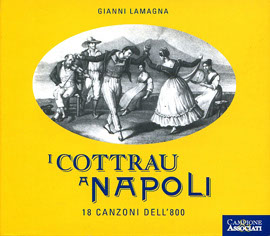
I COTTRAU A NAPOLI
18 songs from 19th Century
1. Fenesta vascia...
2. Antonia'
3. I sospiri
4. Ogg'a rotto se sposano...
5. Filli adurabili...
6. Lu faenzaro
7. U mare che ba'
8. La nuova Ricciolella
9. Addio a Napoli
10. Serment d'amour
11. Tarantella Calabrese e pizzica pizzica Tarantina
12. Fenesta co'sta nova gelosia...
13. Raziella
14. Lu labbru
15. Palummella
16.Quanno vaco a lu lietto...
17. La Chitarrella
18. Santa Lucia
1997
AMATE CANTATE
1. 'A vucchella
2. Silenzio cantatore
3. La Luisella
4. Lo marenaro
5. S'io fosse
6. Ammore 'nnucente
7. L'acquaiuolo
8. Core 'ngrato/Chi tene 'o mare/Alleria
9. Napulitanata
10. Serenata napulitana
11. Nanassa
12. Indifferenza
13. E bonasera ammore
14. Palomma 'e notte
15. 'O surdato 'nnammurato
16. Llà ri llì rà
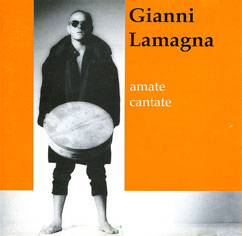
GIANNI LAMAGNA
PARTICIPATIONS
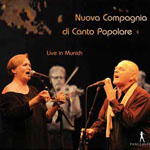
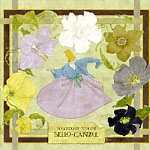
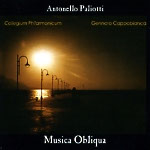
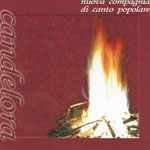
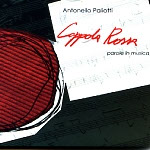
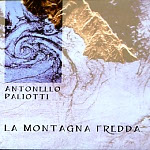
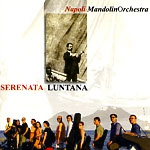
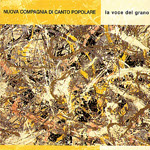
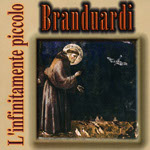
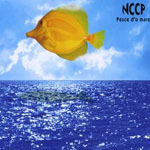
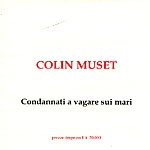
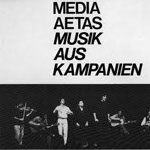

GIANNI LAMAGNA
Discography

GIANNI LAMAGNA
Shows
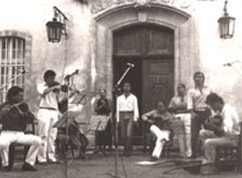
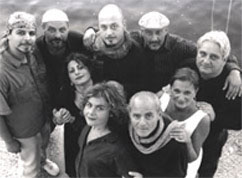
.... Gianni Lamagna is an artist of the 19th century lost in the contemporary world. I have never known more human and more stubborn, more elegant and more coarse, more ambiguous and more linear person and all that on the same time and with a voice that allows him to sing with the same boldness Schoenberg and Gaetano Lama, Goethe and Libero Bovio.
In the force of his interpretations, there's the secret of someone who loves the music from the most remote folds of his soul, without any forcing of diva.
His most beautiful quality: the generosity...
... One needs to understand that the Neapolitan cultural heritage, in which we have to include who does really make culture, has remained, by virtue of some strange alchemy, submerged and Gianni Lamagna is really and truly an example of "high" musical culture. His continual research onto the voice, his way of experimenting new directions, has yielded results that are very much living and widespread…
... Gianni Lamagna reveals a suppleness, an acute sense of eclecticism that only his exceptional voice knows how to unify. Amate Cantate, in the voice of Gianni Lamagna, between honey and Greek tragedy, sings the warmth of the weather and the weeping of angels...
... Gianni Lamagna and Antonello Paliotti, working side by side, have elaborated a project that has effectively succeeded in distancing the interpretation from the model used abusively...
... Lamagna, accompanied by the Colin Muset Ensemble and his Concertino offers a lesson in interpretative eclecticism ranging from tha pieces by Viviani to popular songs, from the foundations of the classic Neapolitan song to pieces that are less universally known and, maybe for that reason, even more deserving to be rediscovered...
... and finally the moment of Bambenella arrives unleashing the phenomenal talent of Gianni Lamagna, who has earned personal and well-deserved success that reverberates on the performance as a whole...
... with the passion and the fervour of one initiated in esoteric doctrines Gianni Lamagna guides, explains and “reveals” his truths, and his stories, justifies the choices of the interesting re-elaborations, the highly particular arrangements by Antonello Paliotti, and sings...
... He reviews the Neapolitan Song, in front of us, but this time it is not drenched in the usual attitudes. At certain moments, you can almost make out a resonance close to that of Strawinskij, or a rhythm that strays into other “continental” dimensions: from Astor Piazzolla to Inti Illimani, right up to a certain modern percussionism...
... a driving thematic thread is decidedly absent. We need, here, to retrace a mental process in which the specifics of a genre no longer counts, but, rather, renewed presentation. The memory, then, is the protagonist; the taste for a “perpetual return” as if going back to a source from which to collect pure water, free of any contamination. Di Giacomo's Era di Maggio, or Core ‘ngrato are not all that far remote from that Menta Cedra and Nanassa that are “musically” performed with irony and fun...
... The songs, hand in hand, turned into a multitude of short stories, like “one-act” pieces that synthesized the tragedies in a brief instant. A song, just like a poem, requires that moment of culminating action, the soul of an emotion. And all of this seems clear to us after having attended Gianni Lamagna's concert, S’io Fosse...
... but there is still room for tenderness and melancholy (Gianni Lamagna is splendid in Vurria addeventà nu suricillo elaborated by the NCCP on Apulian traditional sounds (Tarantelle del Gargano)...
... in reality, the true Neapolitan Song, was written and sung for a city that no longer exists, a city destroyed both physically and anthropologically: there are no longer those particular conditions that, for centuries, inspired the poetry of the songs, and the styles of traditional songs have been forgotten in order to follow new fashions
What we need now is silence; that would allow us not to hear the too many confused, degrading and debasing voices. We could then go back to that city and lose ourselves in the meanderings of its history and its genuine legends, among the great writers and performers, but with the somewhat painful knowledge that, in reality, that world can never come back, unless it’s in the miraculous form of a great voice singing.
... A musical operation of big artistic value, this I Cottrau a Napoli, that Gianni Lamagna, incontestable interpreter of the big Neapolitan popular tradition, offers to the history of his city...
... Through the eighteen pieces, Lamagna browses, with a particular sensitivity, the repertoire of the songs of the Cottrau with the style, non common, of one who knows how to give the energy to the interpretation but without shouting. A beautiful concert, and a beautiful opportunity to shine and to continue to maintain lit the fire of the art...
... The big musical passion that characterizes Gianni Lamagna allowed him to interpret to best the pieces of the Cottrau with a cool and powerful voice worthy of the big interpreters of the beginning of the 20th century...
... a CD and a concert to listen to a voice and a music without time, an opportunity to know in depth the extraordinary artistic and musical heritage of the city of Naples...
... it is sufficient to listen with a argued calmness the precious homage that a rigorous singer as Gianni Lamagna wanted to engrave on a CD,I Cottrau a Napoli, to discover an excellent, simple interpretation that doesn't let itself ever go to vain baroque virtuosity...
... a voice of an extraordinary intensity that moves of once to the other on a reinvented musical background, through refined arrangements, and that finishes by suggesting interpretations considerably faraway of the traditional models of the Neapolitan Song.
... after thirty years of career based on a big will to look at himself in the infinite sea of the Neapolitan musical heritage, Gianni Lamagna shows an insatiable "thirst" again to experiment new ways for music and the theater.
... the Forme Incantate is a big concert, a great Lamagna with original and surprising arrangements, in this the Lamagna-Paliotti association is part of the most interesting ones of the moment regarding to the valorization of a Neapolitan Song far from all oleography.
... Gianni Lamagna wanted to pursue his thirtieth year of research in the domain of the Neapolitan music with a heterogeneous and original work that rediscovers songs of the tradition among the most known and at the same time to reinterpret big partenopean success.
The “Forme” want to recall the diversity of the artistic expressions mingled in scientists compositions of odd and melancholic atmospheres and fantasies more happy and popular. The Forme Incantate bring back us to the shapes of our identity that are a lot more varied than we think it, a historic exercise, therefore, not to forget our origins that however resident in the lightness of some chords of guitar and a special, intense voice.
The ingredients were all united to give life to a big evening of spectacle in the court of the Maschio Angioino with the talented and fickle artist Gianni lamagna, the musical direction of Antonello Paliotti, the participation of Totò's daughter, Liliana De Curtis, the presence of the mayor of Naples and a big crowd. Such is the preamble of the big Concerto per un Principe, a feast in music that celebrated Totò, artist unique to the world, for the fortieth anniversary of his death.
An excellent Gianni Lamagna that has surpassed himself, between narration and bel canto, was with his "Totò" the protagonist of the evening, during which took life music and poetry of the big comedian, poet, actor, author and musician.
A concert of true musical rejoicing and melancholic reflections for a long time applauded by a numerous public among which many Neapolitan artists and institutional personalities.
TEXTS BY: A. Orselli, M. Della Felba, P. Monti, F.Chiari, A. Paliotti, F. Vacalebre, S. Albertini, F. Parrot, A. Savioli. S. Di Maio, A. Billwiller, G. Capurro, M.G. Poggiagliolmi, S. de Stefano, G. Giorgio, A. Stromillo, S. Piedimonte, R. D’Agostino, A. Finizio .

GIANNI LAMAGNA
Press Quotes

GIANNI LAMAGNA
Photos

GIANNI LAMAGNA
Links

PLEASE GO AHEAD !
CONTACTS
For any request, send me an Email!
Contacts
viale J.F.Kennedy, 395
80125 Napoli
Italy
tel/fax +39 081 57 03 385
email : dimusica@libero.it
web : www.dimusicainmusica.it
Booking&Management:
tel : +39 328 61 88 754
email : info@soundfly.it
web : www.soundfly.it
webmaster : michele.laurent@gmail.com


OFFICIAL WEBSITE
